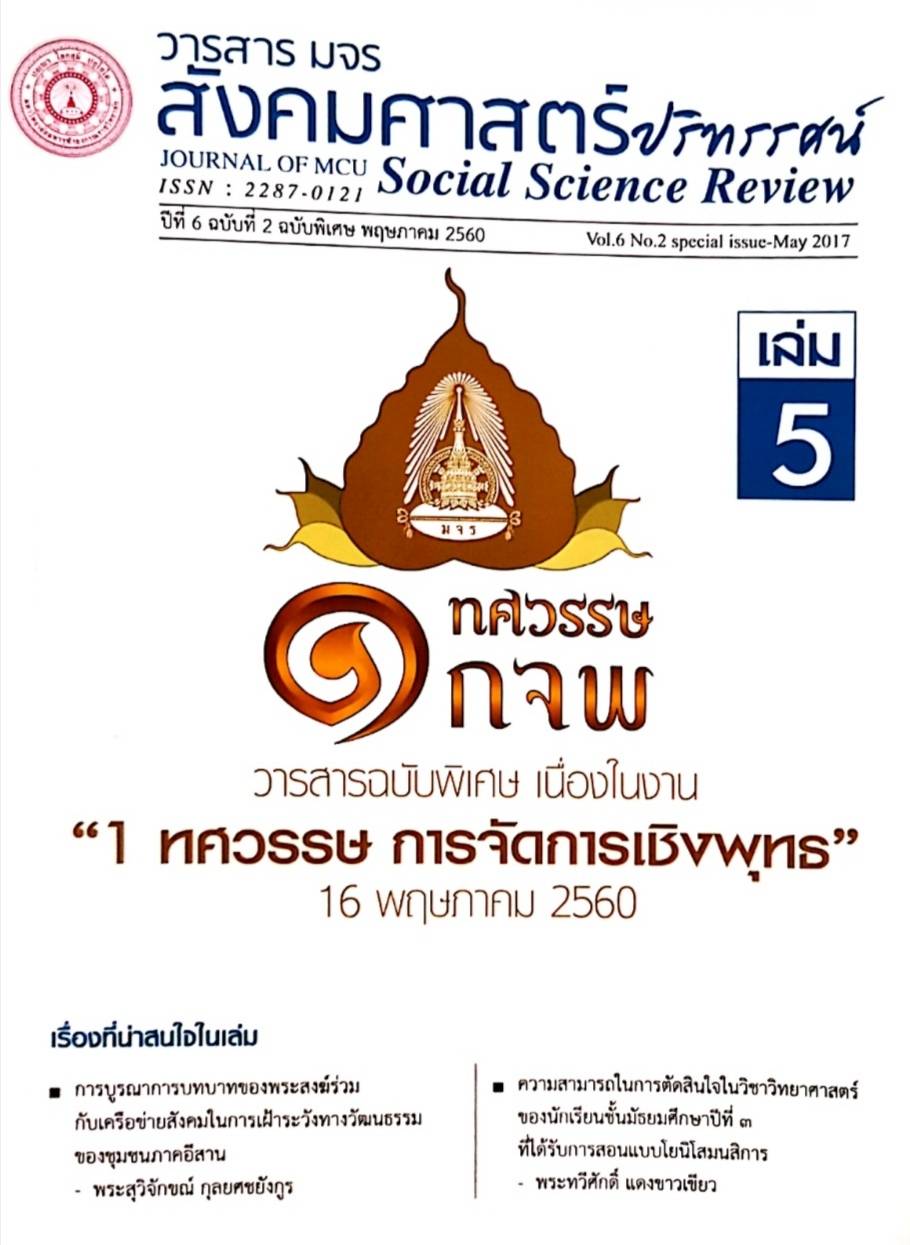รูปแบบการบริหารงานแบบมีส่วนร่วมตามหลักอปริหานิยธรรมของเทศบาลตำบลในจังหวัดสุรินทร์
คำสำคัญ:
รูปแบบ, การบริหารงานแบบมีส่วนร่วม, เทศบาลตำบลบทคัดย่อ
การวิจัยครั้งนี้มีวัตถุประสงค์เพื่อ 1) ศึกษาสภาพทั่วไปของการบริหารงานแบบมีส่วนร่วมของเทศบาลตำบลในจังหวัดสุรินทร์ 2) ศึกษาแนวคิด ทฤษฎีเกี่ยวกับการบริหารงานแบบมีส่วนร่วมและหลักธรรมที่ใช้ในการบริหารงาน และ 3) เพื่อนำเสนอรูปแบบการบริหารงานแบบมีส่วนร่วมตามหลักอปริหานิยธรรมของเทศบาลตำบลในจังหวัดสุรินทร์ ผลการวิจัย พบว่า
- สภาพทั่วไปของการบริหารงานแบบมีส่วนร่วมของเทศบาลตำบลในจังหวัดสุรินทร์ พบว่า การบริหารงานแบบมีส่วนร่วมของเทศบาลตำบลในจังหวัดสุรินทร์โดยรวมอยู่ในระดับมาก
( = 3.68, S.D. = 0.63) เมื่อจำแนกเป็นรายด้านสามารถเรียงลำดับได้ ดังนี้ ด้านการมีอิสระในการปฏิบัติงาน มีระดับสูงสุด ( = 3.72, S.D. = 0.72) รองลงมา คือ ด้านเป้าหมายและวัตถุประสงค์ร่วมกัน ( = 3.70, S.D. = 0.69) ด้านความผูกพัน ( = 3.69, S.D. = 0.75) และที่อยู่ในระดับสุดท้ายคือด้านการไว้วางใจกัน ( = 3.61, S.D. = 0.76) - แนวคิด ทฤษฎีเกี่ยวกับการบริหารงานแบบมีส่วนร่วมและหลักธรรมที่ใช้ในการบริหารงาน ได้แก่ การบริหารงานแบบมีส่วนร่วมมี 4 ด้าน คือ 1.ด้านการไว้วางใจกัน 2.ด้านความผูกพัน 3.ด้านเป้าหมายและวัตถุประสงค์ร่วมกัน 4.ด้านการมีอิสระในการปฏิบัติงาน ประยุกต์ใช้กับหลักอปริหานิยธรรม 7 ประการ ได้แก่ 1. ด้านหมั่นประชุมเป็นเนืองนิตย์ 2. ด้านพร้อมเพรียงกันประชุม พร้อมเพรียงกันเลิกประชุม 3. ด้านการไม่บัญญัติ หรือไม่ล้มเลิกข้อบัญญัติตามอำเภอใจ 4. ด้านการเคารพเชื่อฟังผู้บังคับบัญชา 5. ด้านการให้เกียรติ และคุ้มครองสิทธิสตรี 6. ด้านการส่งเสริม และรักษาวัฒนธรรมประเพณีอันดีงามa7. ด้านการอารักขา คุ้มครอง ปกป้องอันชอบธรรม
- รูปแบบการบริหารงานแบบมีส่วนร่วมตามหลักอปริหานิยธรรมของเทศบาลตำบลในจังหวัดสุรินทร์ มี 4 รูปแบบ ได้แก่ 1) รูปแบบการไว้วางใจกันตามหลักอปริหานิยธรรมของเทศบาลตำบลในจังหวัดสุรินทร์ 2) รูปแบบความผูกพันตามหลักอปริหานิยธรรมของเทศบาลตำบลในจังหวัดสุรินทร์ 3) รูปแบบเป้าหมายและวัตถุประสงค์ร่วมกันตามหลักอปริหานิยธรรมของเทศบาลตำบลในจังหวัดสุรินทร์ 4) รูปแบบการมีอิสระในการทำงานตามหลักอปริหานิยธรรมของเทศบาลตำบลในจังหวัดสุรินทร์ แต่ละรูปแบบมี 3 ระดับได้แก่ 1) ระดับบุคคล 2) ระดับการปฏิบัติงาน 3) ระดับผู้บริหารองค์กร และมี 12 องค์ประกอบ ได้แก่ 1) มีความรู้คู่คุณธรรม 2) ทันต่อเหตุการณ์ 3) รับผิดชอบต่อส่วนรวม 4) มนุษยสัมพันธ์ที่ดี 5) การรวมพลัง ปรองดอง สมานฉันท์ 6) นำหลักการและหลักธรรมชี้นำองค์กร 7) มีระเบียบวินัย ใช้ชีวิตสมดุล 8) ปฏิบัติหน้าที่ตามฉันทามติ 9) ใช้หลักธรรมาธิปไตย 10) มีจิตสำนึกที่ดีต่อสังคม 11) ใช้ความสามารถปฏิบัติงานให้มีประสิทธิภาพ 12) หลักการบริหารจัดการที่ดี
เอกสารอ้างอิง
ถวิลวดี บุรีกุล. (2552). พลวัตรการมีส่วนร่วมของประชาชน: จากอดีตจนถึงรัฐธรรมนูญแห่ง ราชอาณาจักรไทย พุทธศักราช 2550. กรุงเทพฯ: บริษัท เอ.พี.กราฟิค ดีไซน์และการ พิมพ์ จำกัด.
นครินทร์ แก้วโชติรุ่ง. (2556). “รูปแบบและหลักการของการปกครองในพระไตรปิฏก”. พุทธ ศาสตรดุษฏีบัณฑิต สาขาวิชาพระพุทธศาสนา. บัณฑิตวิทยาลัย: มหาวิทยาลัยมหา จุฬาลงกรณราชวิทยาลัย.
วิชญาภา เมธีวรฉัตร. (2558). “รูปแบบการพัฒนาทรัพยากรมนุษย์เชิงพุทธของมหาวิทยาลัยราชภัฏ ภาคเหนือตอนล่าง 2”.พุทธศาสตรดุษฏีบัณฑิต สาขาวิชารัฐประศาสนศาสตร์. บัณฑิต วิทยาลัย: มหาวิทยาลัยมหาจุฬาลงกรณราชวิทยาลัย.
วิทยา จันทร์แดง. (2556). “การพัฒนารูปแบบการบริหารจัดการชุมชนเข้มแข็งตามแนวปรัชญา เศรษฐกิจพอเพียงในเขตจังหวัดภาคกลางตอนบน”. วิทยานิพนธ์รัฐประศาสนศาสตร ดุษฎีบัณฑิต. วิทยาลัย นวัตกรรมการจัดการ:มหาวิทยาลัยราชภัฏวไลยอลงกรณ์ใน พระบรมราชูปถัมภ์.
วิรัช กลิ่นสุบรรณ์. (2555). “การศึกษาเปรียบเทียบการปกครองของแคว้นวัชชีกับรัฐธรรมนูญแห่ง ราชอาณาจักร ไทยปีพุทธศักราช 2550”. สารนิพนธ์พุทธศาสตรดุษฏีบัณฑิต. บัณฑิต วิทยาลัย: มหาวิทยาลัยมหาจุฬาลงกรนราชวิทยาลัย.
ศิริลักษณ์ สุวรรณวงศ์. (2538). ทฤษฎีและเทคนิคการสุ่มตัวอย่าง. กรุงเทพฯ: โอเดียนสโตร์.
เสนอ อัศวมันตา. (2558). “รูปแบบการบริหารจัดการตามหลักอปริหานิยธรรมขององค์การบริหาร ส่วนจังหวัดนนทบุรี”.พุทธศาสตร์ดุษฎีบัณฑิต สาขารัฐประศาสนศาสตร์. บัณฑิต วิทยาลัย: มหาจุฬาลง กรณราชวิทยาลัย.
อภินันท์ จันตะนี. (2549). การใช้สถิติวิเคราะห์ข้อมูล สำหรับการวิจัยทางธุรกิจ. ฝ่ายบัณฑิตศึกษา คณะวิทยาการจัดการ: มหาวิทยาลัยราชภัฏพระนครศรีอยุธยา.
อากาศ อาจสนาม. (2558). “รูปแบบการพัฒนาสมรรถนะพยาบาลเชิงพุทธบูรณาการของพยาบาล สังกัดกรม แพทย์ทหารเรือ”.พุทธศาสตร์ดุษฏีบัณฑิต สาขาวิชารัฐประศาสนศาสตร์. บัณฑิตวิทยาลัย: มหาวิทยาลัยมหาจุฬาลงกรณราชวิทยาลัย.
ดาวน์โหลด
เผยแพร่แล้ว
รูปแบบการอ้างอิง
ฉบับ
ประเภทบทความ
สัญญาอนุญาต
ลิขสิทธิ์ (c) 2020 วารสาร มจร สังคมศาสตร์ปริทรรศน์

อนุญาตภายใต้เงื่อนไข Creative Commons Attribution-NonCommercial-NoDerivatives 4.0 International License.
เพื่อให้เป็นไปตามกฎหมายลิขสิทธิ์ ผู้นิพนธ์ทุกท่านต้องลงลายมือชื่อในแบบฟอร์มใบมอบลิขสิทธิ์บทความให้แก่วารสารฯ พร้อมกับบทความต้นฉบับที่ได้แก้ไขครั้งสุดท้าย นอกจากนี้ ผู้นิพนธ์ทุกท่านต้องยืนยันว่าบทความต้นฉบับที่ส่งมาตีพิมพ์นั้น ได้ส่งมาตีพิมพ์เฉพาะในวารสาร มจร สังคมศาสตร์ปริทรรศน์ เพียงแห่งเดียวเท่านั้น หากมีการใช้ภาพหรือตารางหรือเนื้อหาอื่นๆ ของผู้นิพนธ์อื่นที่ปรากฏในสิ่งตีพิมพ์อื่นมาแล้ว ผู้นิพนธ์ต้องขออนุญาตเจ้าของลิขสิทธิ์ก่อน พร้อมทั้งแสดงหนังสือที่ได้รับการยินยอมต่อบรรณาธิการ ก่อนที่บทความจะได้รับการตีพิมพ์ หากไม่เป็นไปตามข้อกำหนดเบื้องต้น ทางวารสารจะถอดบทความของท่านออกโดยไม่มีข้อยกเว้นใดๆ ทั้งสิ้น





